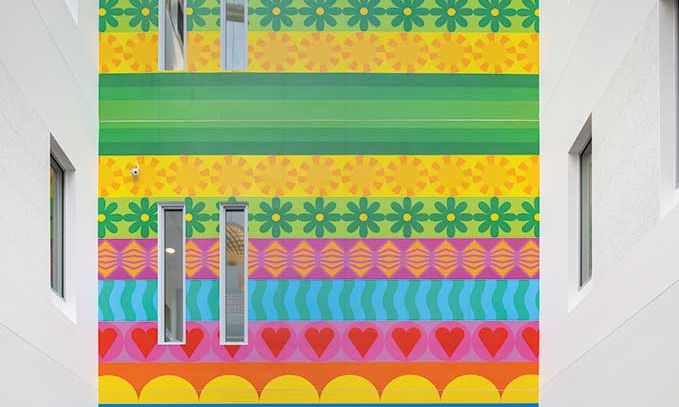Yinka Ilori’s mural brings colour and cheer to London’s Springfield Hospital
Photo: Damian Griffiths. Courtesy of Hospital Rooms
As anyone who has spent time in hospital knows, they are often the least hospitable of places. Noisy, harshly lit, often rundown and blandly decorated, many hospital buildings seem at odds with any sense of care for either patients or staff. And for those with serious mental illness, they can make an already difficult situation unbearable.
It was a recognition of this grim state of affairs that led to the foundation of Hospital Rooms, the UK arts and mental health charity, which aims to provide people using hospital mental health services with a more welcoming and dignifying environment by commissioning site-specific, museum-quality art. The impetus for Hospital Rooms came when its cofounders, the artist Tim A. Shaw and the curator Niamh White, visited a friend who had been admitted to hospital following a suicide attempt. “We were struck by how inhumane the ward felt, so cold and clinical and also dilapidated,” they recall. “At a time when she was so vulnerable, it felt like the environment was doing the complete opposite of what you’d want it to.”
The pair set up Hospital Rooms, which completed its first project in 2016 in the Phoenix Unit, a south-west London rehabilitation facility for people with schizophrenia. Art permeates the building, from the noticeboard designed by the Turner Prize-winning collective Assemble, to the communal lounge decorated with works by photographer Nick Knight (one of which had its twin simultaneously on show in the National Gallery), and a quirky “double egg” wall work by Gavin Turk in its Resource Room. Since then, Hospital Rooms has commissioned leading artists including Richard Wentworth, Mark Wallinger, Jade Montserrat, Tschabalala Self and Harold Offeh to produce bespoke work for more than ten mental health facilities across the UK. These include a mother and baby unit in Exeter, a forensic secure unit in Norwich, an adolescent unit in the Maudsley Hospital south London and a locked unit for older people with dementia in Highgate, north London. Each project is shaped and informed by a programme of workshops with artists, staff and patients, which Shaw and White consider to be “an integral part of the Hospital Rooms process”.
Michelle Williams-Gamaker’s work references Hygieia, the Greek goddess of health
Photo: Damian Griffiths. Courtesy of Hospital Rooms
Last summer, Hospital Rooms entered into a partnership with Hauser & Wirth gallery, which has committed to raising £1m for the organisation by 2025. This month sees it upping its game by unveiling more than 20 major bespoke works for two new mental health facilities built at Springfield Hospital in Tooting, south London. These light, airy buildings radically transform how you’d expect a mental health hospital to look and feel with visually arresting works in a multitude of media.
Entering via the lofty top-lit main atrium, it’s impossible to miss a pair of giant collaged works by Michelle Williams-Gamaker that fuse photographic images of animals, flowers and classical deities, including Hygieia, the Greek goddess of health; while the staircase leading into a secure forensic unit has now become a limpid forest grove, rendered in Hurvin Anderson’s fluid brushstrokes.
Harold Offeh worked with Springfield patients to make individual clay tiles inspired by their personal and cultural experiences, which punctuate his mural work in the Trinity Recovery College. Nearby another tall, light-drenched hallway is emblazoned with Yinka Ilori’s vivid rainbow billboard declaring, “Hope for A Better Tomorrow”. For the third of Springfield’s three-storey internal atria, Sutapa Biswas has created a stylised night sky influenced by Giotto’s 14th-century Scrovegni Chapel, in which an entire wall is painted ultramarine blue and emblazoned with a cascading waterfall of gold-leaf stars. In the multifaith room Abbas Zahedi, who won the 2022 Frieze Artist Award, gives an abstract stained-glass effect by covering the windows and skylights in semi-transparent vinyls printed with marbleised patterns.
In keeping with Hospital Rooms practice, these and all the other works for Springfield emerged out of the artists leading more than 80 workshops with the hospital trust, service users and staff. Also, in an especially savvy move given the market value of many of the artists involved, and given the cash-strapped state of the NHS, if any of the participating hospitals attempt to sell the works, the artists in question have agreed not to authenticate them. The value of each work thus relies solely on its relationship to its specific location. And judging by the overwhelmingly positive response from all those currently experiencing them, this value is inestimable.

